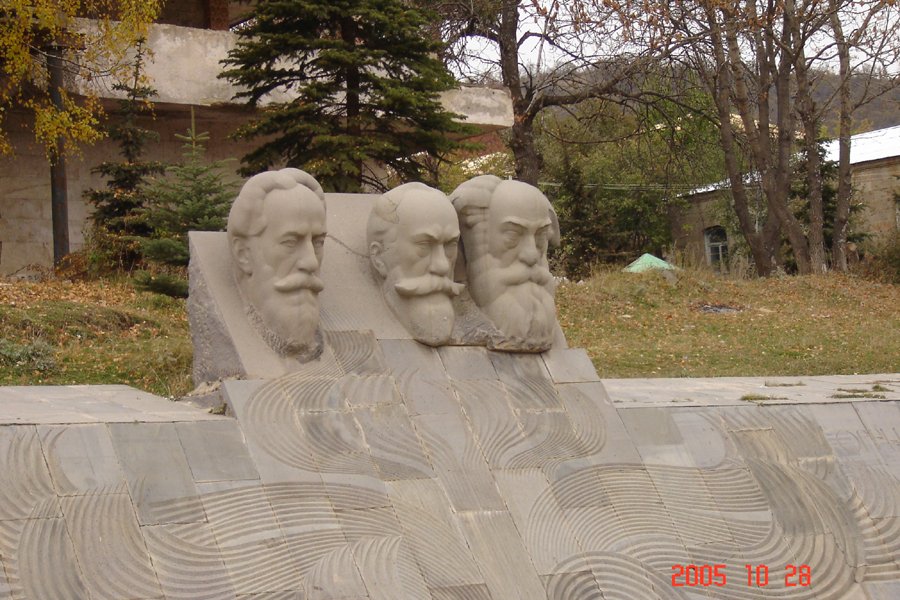
(� K. Vrtanesyan)
Armenian News Network / Groong
March 20, 2006
Travel Wire
By Ruth Bedevian
TSAGHKADZOR, ARMENIA

|
|
Orbeli Brothers Monument (� K. Vrtanesyan) |
Despite the light drizzle of rain and overcast clouds of a late October day, Geraseem and Marineh Megerdichian stood on the portico of the Orbeli Brothers' Museum in Tsaghkadzor and eagerly greeted our party of three with warm smiles. Before we introduced ourselves, Marineh candidly revealed her curiosity and queried, `What is your interest in the Orbeli brothers and why have you come here today?' I straightforwardly responded, `I knew nothing about these brothers!' I then embellished with my own question, `What better source should I seek to learn about them?'
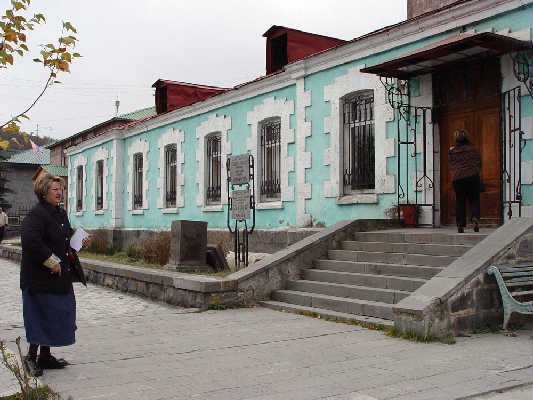
|
|
Orbeli Museum (� K. Vrtanesyan) |
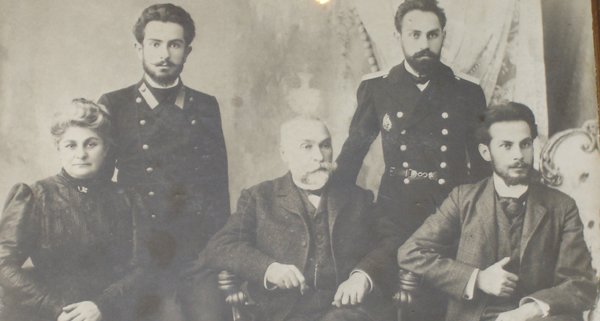
|
|
Orbeli Family Photo (� K. Vrtanesyan) |
Ruben, the eldest (1880-1943), was the father of underwater archaeology in the USSR. Levon (1882-1958) was a famous physiologist and member of the Soviet Academy of Sciences; the youngest, Hovsep (1887-1961), was a leading Orientalist and director of the Hermitage Museum in Leningrad. Only one brother (Levon) was born in Tsaghkadzor, but all three spent their childhood years there. The building in which over 2000 items are archived was the home of Abcar Orbeli (father of Ruben, Levon and Hovsep), an alumnus of the Law School of St. Petersburg University who worked in the Czar's service. From correspondence it was learned that Khrimian Hayrig had invited Abcar to Etchmiadzin, the Holy See, for tea in 1896. Following such a privileged visit with the Catholicos of All Armenians, he wrote to a friend, `He's a pretty good fellow!'
Vartanoush, the mother, came from a noble family and was well educated. Marineh informed us that she was educated in Tiflis and taught French. Obviously enjoying her narrative of this remarkable mother, Marineh quoted Vartanoush's advice to her sons, `Study well and become famous so I will become famous!' Vartanoush was also fond of saying that she graduated four times - once on her own and three times more for each son. The Orbelis' paternal grandfather was a priest (Father Hovsep) who had served in Astrahkan, Tbilisi and St. Petersburg.
We strolled pleasantly through six rooms of memorabilia which included copies of published scientific works and photographs of relatives who were outstanding in dentistry and psychiatry. Both Geraseem and Marineh's anecdotes created lively history. Marineh related that Davit Orbeli - the paternal uncle - is credited with saving the famous revolutionary, Kamo. Kamo pretended to be insane in order to escape punishment. Davit who was a prominent and respected psychiatrist, was asked to examine him. He declared that he was not pretending and Kamo was freed.' A trilogy of films were produced at Hyefilm in the 1970s about Kamo ("Andzamb Tchanachum Em" ('I Personally Know Him') and "Artakarg Handznararutyun" ('Extraordinary Recommendation') directed by S. Kevorkov and E. Karamian, and "Kamoyi Verjin Sxranqy" ('Kamo's Final Exploit') directed by S. Kevorkov and G. Melik-Avagyan), and Davit Orbeli's work is reflected in one of the films, although he is left unnamed.
Rich in artifacts, the museum's sources derive from Levon's daughter, granddaughter and the Hermitage Museum (St. Petersburg, Russia). A wealth of information has also been documented in plentiful correspondence that has been given by family members and friends. These archived letters have richly added to the chronicle of the Orbeli brothers - their personal and professional lives as well as their contributions. Hovsep Orbeli's silver medals and photo at Nuremberg were very thought provoking.
RUBEN - the first born- and whose room we entered first, knew 12 languages. He graduated from Law School (like his father) from St. Petersburg University. He became a state senator and secretary of the Arbitration Commission prior to the 1917 revolution. After the revolution, he redirected his career and became one of the first underwater archeologists, concentrating much of his work in the Black Sea and the River Buk. He authored books and papers on scientific diving and became a noted authority on the history of ancient diving techniques in Greece and Rome. A paper he prepared on his study of Leonardo DaVinci's research on diving technologies is on display. His PHD thesis was on Ancient Armenian Marriage Law.
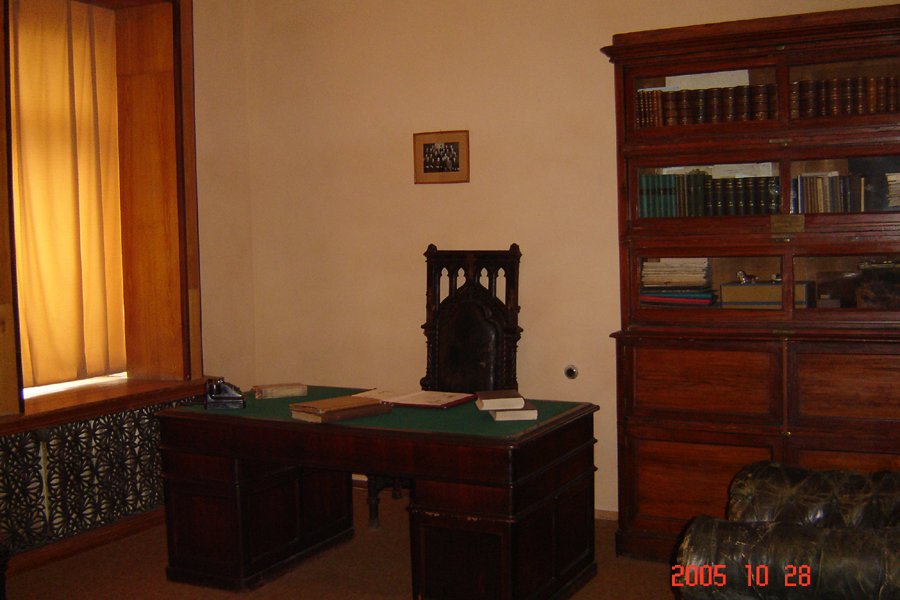
|
|
Levon's Desk (� K. Vrtanesyan) |
LEVON, the middle child, founded the Physiology Institute of Armenia in Yerevan (1946). Orbeli Street in Yerevan is named after him. His national fame grew to international fame as evidenced in the following quote from The Nation Magazine, `One need hardly mention such names as Pavlov, 'Speransky, and [Levon] Orbeli, ... to remind us of Czarist Russia's high achievements in medicine.' Levon attended a Military Medical School and studied under the world famous Ivan Pavlov, 1904 Nobel Prize Laureate. Geraseem said that a close association and respect formed between teacher and student and that Levon's future work took direction from Pavlov's influence. Both scientists' upbringing gave them much in common as Pavlov came from a family also grounded in humane purpose as well. At the age of 26 Levon published his doctorate and for the next three years of his life he visited Germany, England and Denmark. He was knowledgeable in seven languages. In 1929 Levon visited Boston to participate in the International Congress of Physiologists. He most enjoyed a trip to the seashore. In 1942 he was appointed director of the Military School and attained the rank of General. He adopted his 6 year old natural grandson when his daughter, a physicist died through a radioactive experiment. He autopsied the body of his own daughter. He pioneered the study of aviation and cosmic health for pilots and astronauts and for this achievement he was bestowed an honorary member of London University. The cap he received on this occasion is on display. Levon anonymously provided funds for many Armenian medical students to study at St. Petersburg University.
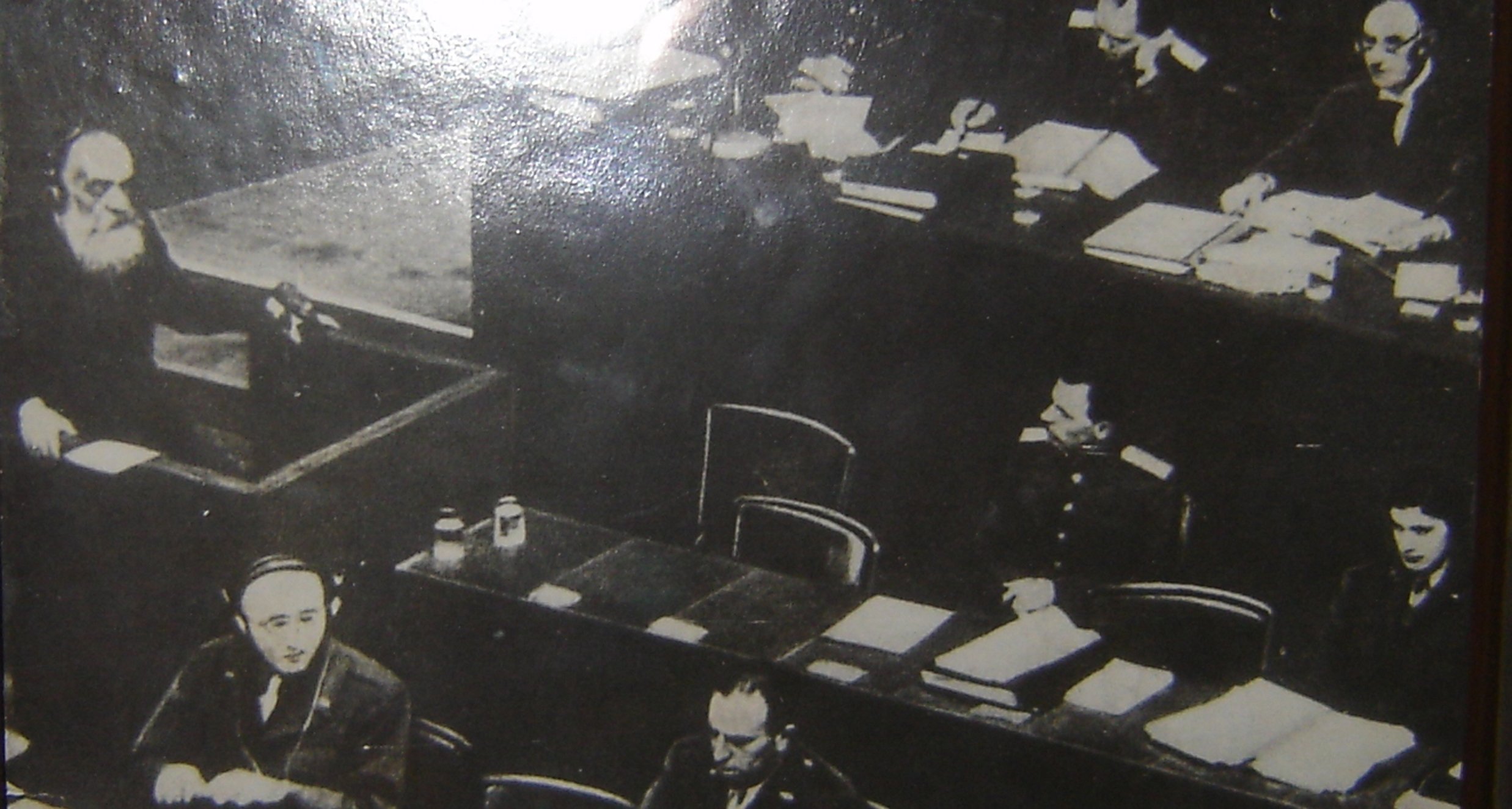
|
|
Hovsep Orbeli's testimony at Nuremberg Trials (Hovsep Orbeli is on the left) |
HOVSEP, the youngest, founded the Armenian Academy of Sciences and presided as its first president (1943). He was born in Tiflis (1887), and graduated from St. Petersburg University, majoring in History. In his 3rd year, he took part in the excavations of Ani which at that time attracted much of the Armenian intelligentsia. He launched his career with this experience in Ani which was a center of Armenian Architecture and a prototype for much of European structures. By 1924 he was appointed the Head of the Oriental Section of the Hermitage Museum. He later went to London during an exhibition of Iranian Art where the Second International Congress of Art was held. He was successful in bringing the 3rd International Congress to the Hermitage. Geraseem related an account which revealed much about the unselfish devotion of this man. He melted all his personal household silver to make medals for the 188 participants for this International Congress. A sample was on display. Embossed on the medal coin was a mythological Iranian figure. He worked for 31 years in the Hermitage of which he was director for seventeen years. He was director during the blockade during World War II when the art was saved from the Nazis by being sent to Sverdlovsk. A photograph in the museum showed him participating in the Nuremberg Trials as a witness to the destruction of art during World War II.
Readers interested in reading by the Orbelis can find few books in English, such as Hovsep Orbeli's "Sasanian and Early Islamic Metalwork. A Survey of Persian Art from Prehistoric Times to the Present" (London - New York, 1938). As for books about them in Armenian and Russian:
Following a thorough tour, we were hospitably treated to refreshments
where we benefited further from pleasant conversation with this
accomplished husband and wife team. How grateful I am for noble
people who value the contributions of noble people who make noble
their nation.
--
Ruth Bedevian continues her visits to Armenian authors' House Museums
around Armenia. Her articles in this series are at:
http://www.groong.org/orig/armeniahousemuseums.html
|
Redistribution of Groong articles, such as this one, to any other
media, including but not limited to other mailing lists and Usenet
bulletin boards, is strictly prohibited without prior written
consent from Groong's Administrator. � Copyright 2006 Armenian News Network/Groong. All Rights Reserved. |
|---|